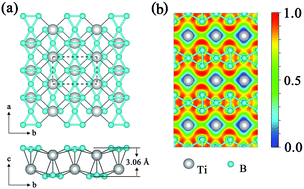A boron-exposed TiB3 monolayer with a lower electrostatic-potential surface as a higher-performance anode material for Li-ion and Na-ion batteries
Abstract
The lack of high-performance anode materials has become a major obstacle to the development of Li- and Na-ion batteries. Recently, 2D transition metal borides (e.g. MBenes) have attracted much attention due to their excellent stability and electrical conductivity. Unfortunately, most of the reported MBene phases typically have an intrinsic metal-rich structure with metal atoms exposed on the surface, which harmfully affect the adsorption of Li/Na atoms. Here, through crystal structure prediction combined with the first-principles density functional theory, a novel TiB3 MBene has been determined by altering the proportion of non-metallic element boron to wrap metal atoms and weaken nearest-neighbor electrostatic repulsion. Electrostatic potential analysis visually shows a surface with low potential on the TiB3 monolayer implying high adsorption capacity, and also can be used to quickly screen out the Li/Na adsorption sites. Accurate half-cell battery simulation confirmably shows that the TiB3 monolayer possesses a theoretical specific capacity of 1335.04 and 667.52 mA h g−1 for Li and Na, respectively. The TiB3 monolayer can remain metallic after adsorbing Li/Na atoms, which ensures good conductivity during battery cycling. The ultra-low barrier energy (only 38 meV for Li) and suitable open-circuit voltage indicate excellent charging and discharging capabilities. These results suggest that the TiB3 monolayer could be a promising anode material for Li- and Na-ion batteries, and provide a simple design principle for exposing non-metallic atoms on the surface.

- This article is part of the themed collection: 2020 PCCP HOT Articles


 Please wait while we load your content...
Please wait while we load your content...